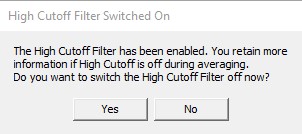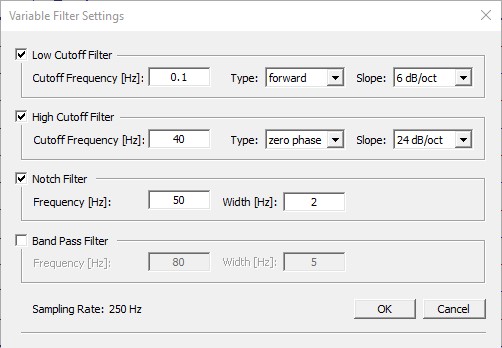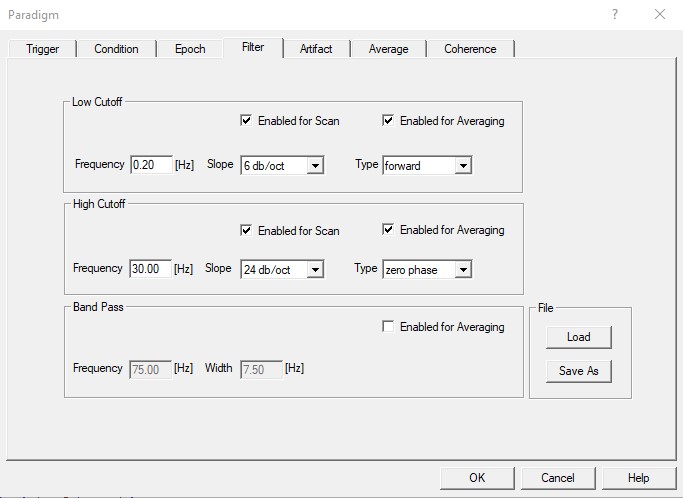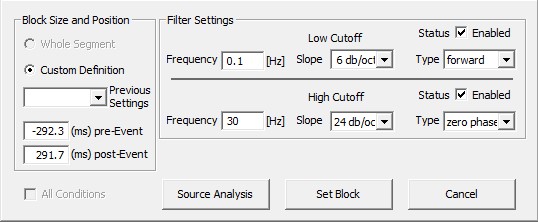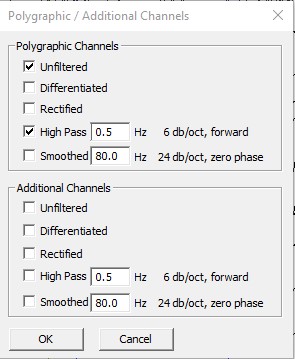Filtering scope
| Module information | |
| Modules | BESA Research |
| Version | 6.1 or higher |
Contents
Overview
In EEG/MEG data analysis frequency filtering is one of the most basic and at the same time important operations. In BESA Research filtering is implemented as a linear operation so it is interchangeable in the processing pipeline - it can be changed at every processing step in almost all situations. There are however some moments that filtering cannot be applied in a linear manner - i.e. averaging. In general, we recommend not to apply filtering during such types of operations (apart from high pass to reduce drifts) as it can still be applied afterwards. You will be prompted by the application if you encounter this type of situation in data analysis:
Also at some stages of the data processing, filtering is of major importance, therefore we made it more accessible and you can easily redefine it. Please have a look at the table below:
| Filter type | Review window | Search Average View | Averaged buffer | FFT | lienear corelation / regression | Combine Conditions | ERP | Coherence | Time Frequency plot (single click) |
TopViewer | Source Analysis |
|---|---|---|---|---|---|---|---|---|---|---|---|
| Low/High pass | Main | Main / can be redefine to default values(2-35Hz) | as used during buffer creation | Main | Main | None | ERP | ERP | Main | Main | SA |
| Notch | Main | Main / can be redefine to default values(2-35Hz) | as used during buffer creation | Main | Main | None | Main | Main | Main | Main | Main |
| Bandpass | Main | Main / can be redefine to default values(2-35Hz) | as used during buffer creation | Main | Main | None | ERP | ERP | Main | Main | Main |
| Polygraphic | Main* | Main* / can be redefine to default values(2-35Hz) | as used during buffer creation | Main* | Main* | None | Main* | Main* | Main* | Main* | n.a. |
| artifact correction | Main | Main / can be redefine to default values(2-35Hz) | as used during buffer creation | Main | Main | Main | ERP | ERP | Main | Main | Main/SA |
Main settings
The main setting for artifact correction can be set using EdF or menu entry Filters/Edit Filter Settings...
Specific ERP settings
The ERP filter settings can be set during paradigm definition. Note that there are two different settings - for artifact scan and for averaging.
Specific Source Analysis settings
For source analysis (SA), if you press ESI/MSI button on the toolbar ribbon Main filter settings will be used. Filters for SA can be set during sending a block of data to Source Analysis (right-click on the highlighted block and select Source Analysis).
In case of enabled artifact correction, you will be prompted just before averaging if you want to average artifact corrected data or not. The detailed description of difference in both approaches can be found here
Notch filter
Note that because of its generic nature - power line artifact removal - the notch filter is treated differently. The notch filter value populates from Main setting to all subsequent applications.
Bandpass filter
The bandpass filter is complementary to the high/low pass filter combination. For convenience, it is treated differently (it also has different filter characteristics) and also populates to all subsequent applications from Main setting.
Polygraphic filter
Polygraphic channels are filtered using Main settings. Note that there are additional settings that can be applied to the polygraphic filter accessible via Filters/Polygraphic/Additional Chans...
